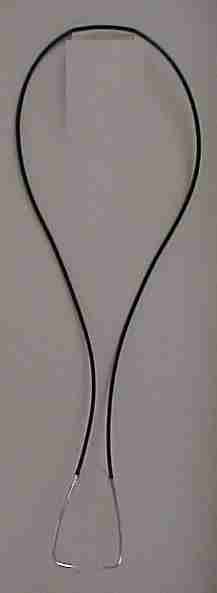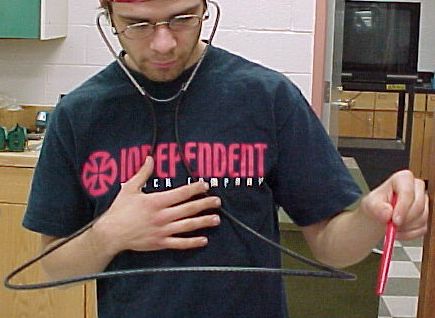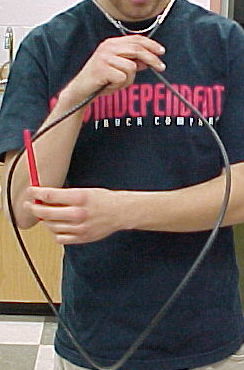Experiment of The Month
Our Acoustic Directionality
We are surprisingly good at locating the source of a sound. This month's simple physics experiment illuminates one of the mechanisms that we use to extract direction from the sound that we hear. Dr. Mizumski is teaching our musical acoustic course (Physics 205) for the first time this semester and, as often happens in such a situation, is developing new experiments for the laboratory component of the course.

MODIFIED

TAPPING THE TUBE
The figure on the left above shows an ordinary stethoscope, with the diaphragm replaced by a length of tubing. The tubing used was a hard polyethylene, Dekoron 1219 FR (flame retardant) tubing, recommended for pneumatic control applications. Because of the hard character, the tube makes a clear tap sound when struck with a pen, as shown in the picture on the right above.
When tapped as shown, the student hears the sound to be coming from his left ear, even though
If the student moves the pen to his right, he hears the sound to come from straight ahead, and then, as the pen crosses the midpoint, it quickly changes to "coming from the right." Dr. Miziumski has students measure the distance along the tube between the "left" and "right" sensations.
Throughout the
This evidence indicates that our
The answer is evidently yes, although, it is easier to believe if we think of the time shift equivalent to a phase shift. We can understand this experiment by assuming that the ear which first receives the sound "declares" the direction. It may seem remarkable that we can detect time differences as small as this (the time for sound to go 20 cm in air being about 0.5 milliseconds), but it seems to be true. Indeed, there is evidence that humans can detect differences as small as .01 milliseconds

-
Contact Information
Contact Number: 717-871-4297
Email: physics@millersville.edu